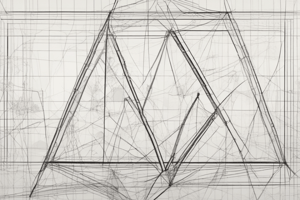Podcast
Questions and Answers
What is the formula to find the area of a circle?
What is the formula to find the area of a circle?
π * r^2
If a circle has a radius of 7 units, what is its area?
If a circle has a radius of 7 units, what is its area?
153.94 square units
How do you find the area of a composite shape?
How do you find the area of a composite shape?
Break it down into the areas of individual shapes and add them together.
If a composite shape consists of a rectangle with an area of 24 square units and a triangle with an area of 10 square units, what is the total area of the composite shape?
If a composite shape consists of a rectangle with an area of 24 square units and a triangle with an area of 10 square units, what is the total area of the composite shape?
What is the formula to find the area of a parallelogram?
What is the formula to find the area of a parallelogram?
How do you calculate the area of a rectangle?
How do you calculate the area of a rectangle?
What is the formula to find the area of a triangle?
What is the formula to find the area of a triangle?
How can you determine the area of a parallelogram?
How can you determine the area of a parallelogram?
What is the key characteristic of a circle in relation to its area calculation?
What is the key characteristic of a circle in relation to its area calculation?
In the context of geometry, what is a composite shape?
In the context of geometry, what is a composite shape?
Study Notes
Area of Shapes
The area of a shape is the amount of space it occupies inside its boundary. This concept is fundamental in geometry and has applications across various fields such as engineering, architecture, construction, and manufacturing. In this article, we will discuss how to calculate the areas of commonly used geometric figures including rectangles, triangles, parallelograms, circles, and composite shapes.
Rectangle
A rectangle is a flat four-sided figure with four right angles, opposite sides equal length, and all angles equal to 90 degrees. To find the area of a rectangle, multiply the length by the width. For example, if a rectangle has a length of 5 units and a width of 10 units, its area is 50 square units (5 * 10).
Triangle
A triangle is a three-sided figure with interior angles that add up to 180 degrees. To find the area of a triangle, multiply the base by the height and divide by 2. For example, if a triangle has a base of 5 units and a height of 10 units, its area is 25 square units (5 * 10 / 2).
Parallelogram
A parallelogram is a four-sided figure with opposite sides parallel and congruent (equal in length). To find the area of a parallelogram, multiply the base by the height. For example, if a parallelogram has a base of 5 units and a height of 10 units, its area is 50 square units (5 * 10).
Circle
A circle is a round, two-dimensional figure with all points on its edge at equal distance to a central point called the center. To find the area of a circle, multiply Pi (π, approximately 3.14159) by the square of the radius (the distance from the center to the edge). For example, if a circle has a radius of 5 units, its area is 78.54 square units (π * 5^2).
Composite Shapes
Composite shapes are made up of two or more basic shapes combined. To find the area of a composite shape, break it down into the areas of the individual shapes it is made up of and add them together. For example, if a composite shape is made up of two circles with radii of 5 units each, its area is 157.08 square units (2 * π * 5^2).
In conclusion, understanding the area of shapes is crucial for various applications in different fields. By knowing how to calculate the areas of rectangles, triangles, parallelograms, circles, and composite shapes, you can effectively solve problems that involve these geometric figures.
Studying That Suits You
Use AI to generate personalized quizzes and flashcards to suit your learning preferences.
Description
Learn how to calculate the areas of rectangles, triangles, parallelograms, circles, and composite shapes in geometry. Understanding the concept of area is essential for various fields like engineering, architecture, and manufacturing.




